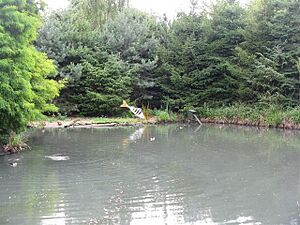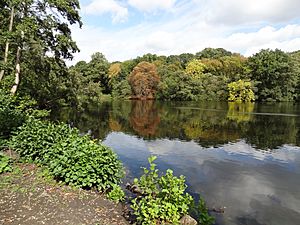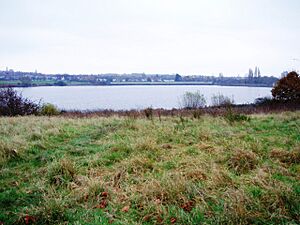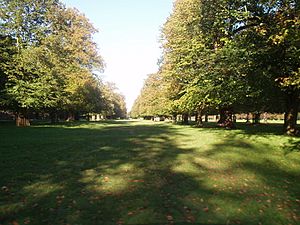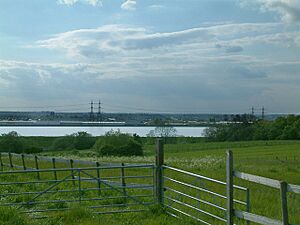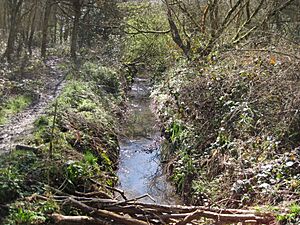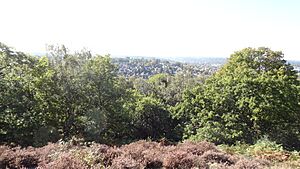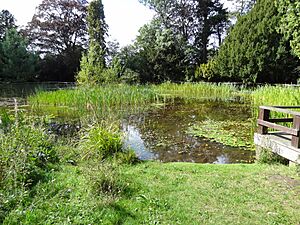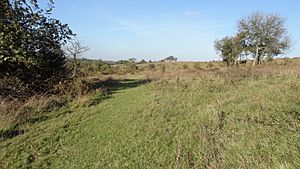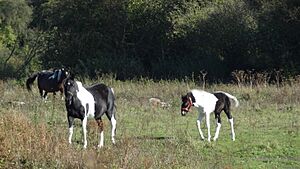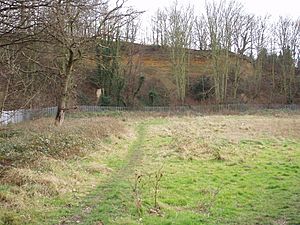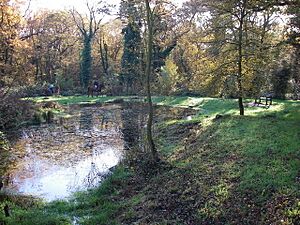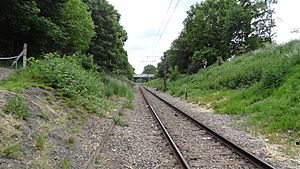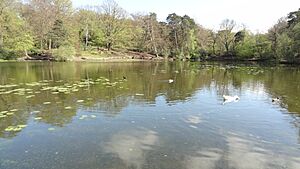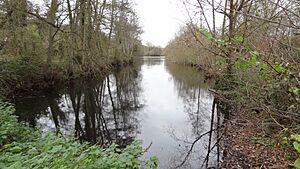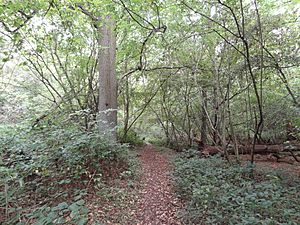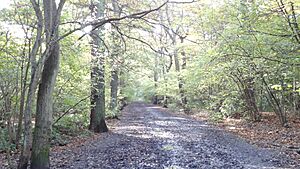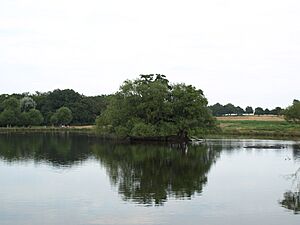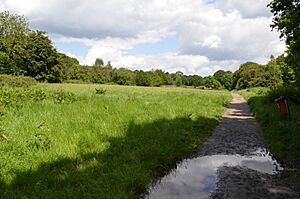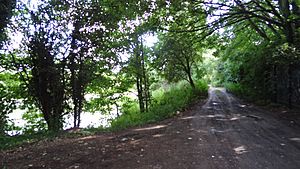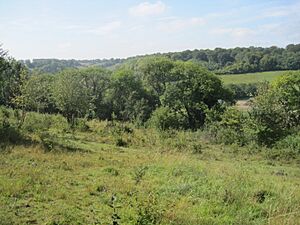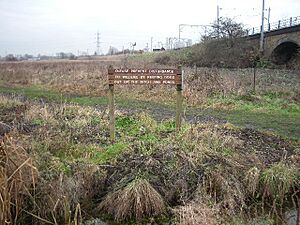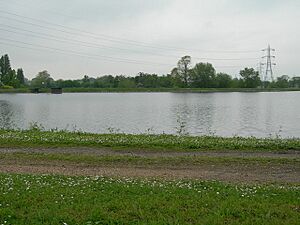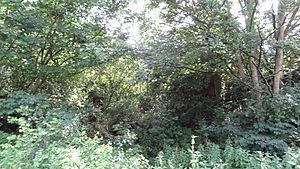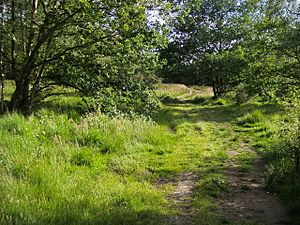List of Sites of Special Scientific Interest in Greater London facts for kids
In England, special places called Sites of Special Scientific Interest (SSSIs) are protected by an organization called Natural England. Their job is to look after England's amazing natural environment.
Being an SSSI means a place gets legal protection because it's super important for its wildlife or interesting rocks and landforms. As of 2019, there are 37 SSSIs in Greater London. Most of these (30) are special for their plants and animals, and 7 are special for their geology.
Greater London is one of the biggest cities in Europe. Even though it's a huge city, almost two-thirds of it is green spaces and wetlands! This shows how important these SSSIs are for nature in a busy urban area.
Contents
- What are SSSIs in London?
- Amazing SSSIs in London
- Abbey Wood
- Barn Elms Wetland Centre
- Bentley Priory
- Brent Reservoir
- Bushy Park and Home Park
- Chingford Reservoirs
- Crofton Woods
- Croham Hurst
- Denham Lock Wood
- Downe Bank and High Elms
- Elmstead Pit
- Epping Forest
- Farthing Downs and Happy Valley
- Frays Farm Meadows
- Gilbert's Pit
- Hainault Forest
- Hampstead Heath Woods
- Harefield Pit
- Harrow Weald
- Hornchurch Cutting
- Ingrebourne Marshes
- Inner Thames Marshes
- Kempton Park Reservoirs
- Keston and Hayes Commons
- Mid Colne Valley
- Old Park Wood
- Oxleas Woodlands
- Richmond Park
- Riddlesdown
- Ruislip Woods
- Ruxley Gravel Pits
- Saltbox Hill
- Syon Park
- Walthamstow Marshes
- Walthamstow Reservoirs
- Wansunt Pit
- Wimbledon Common
- Images for kids
- See also
What are SSSIs in London?
SSSIs are like nature's VIP areas. They are chosen because they have rare plants, animals, or unique geological features. Protecting these sites helps keep London's natural world healthy and diverse.
Some of these SSSIs have extra special protections:
- Two are Special Protection Areas (SPAs) for birds.
- Three are Special Areas of Conservation (SACs) for habitats and species.
- One is a Ramsar wetland site, which means it's important for wetlands worldwide.
- Two are national nature reserves (NNRs).
- Nine are local nature reserves (LNRs).
- Seven are Geological Conservation Review (GCR) sites, meaning they are important for studying Earth's history.
Many different groups help manage these sites, like the London Wildlife Trust and the Royal Society for the Protection of Birds (RSPB).
Amazing SSSIs in London
Here are some of the special SSSIs you can find in Greater London:
Abbey Wood
This site is special for its geology. You can find rocks here that are 50 to 60 million years old! These rocks have given us some amazing fossils, including one of only two ancient birds ever found in Britain.
Barn Elms Wetland Centre
This is a fantastic place for wildlife, especially birds. It has a mix of open water, marshland, and reed beds. Many birds, like shovelers, gadwalls, and little grebes, call this home. It's managed by the Wildfowl & Wetlands Trust (WWT).
Bentley Priory
This site is a local nature reserve (LNR) and is important for its plants and birds. You can find grasses like common bent and red fescue here. Rare wildflowers like greater burnet and spotted orchid also grow. Look out for birds like buzzards and bullfinches!
Brent Reservoir
This reservoir is an LNR and is very important for its nesting birds. Many great crested grebes nest here. Other birds you might see include coots and tufted ducks. There are also swampy areas and wet woodlands.
Bushy Park and Home Park
These parks are special because they have lots of dead and decaying wood. This might not sound exciting, but it's a perfect home for many rare insects, especially beetles! The parks also have very old trees and special grasslands.
Chingford Reservoirs
These reservoirs are a major spot for wildfowl in winter. Huge numbers of shovelers and great crested grebes come here. Over 85 different kinds of wetland birds have been seen at this site!
Crofton Woods
This is a large area of very old woodland. It has many different types of trees, shrubs, and plants. The ancient parts of the wood are mostly oak and hazel. It's also home to many different insects.
Croham Hurst
This site is on a steep hill and has a wide variety of plants. On the lower parts, you'll find oak and hazel. Higher up, there are beech trees, and near the top, you'll see oak and birch. It's a great place to see how different soils affect what grows.
Denham Lock Wood
This is a wet woodland and fen area, with the Frays River flowing nearby. The main trees are alder and crack willow in the wettest spots, and oak and ash elsewhere. In winter, you can see wildfowl, and in spring, many flowers bloom. It's also home to rare insects and the protected Desmoulin's whorl snail.
Downe Bank and High Elms
Downe Bank is a meadow and woodland linked to the famous scientist Charles Darwin. High Elms is a woodland with some locally rare plants like green hellebore and bird's-nest orchid. It's managed by the Kent Wildlife Trust (KWT) and is also an LNR.
Elmstead Pit
This small pit is important for geology. It shows layers of rock from about 50 million years ago, during the Eocene epoch. These rocks contain many fossils of ancient sea creatures like molluscs, sharks' teeth, and fish scales.
Epping Forest
Epping Forest is a huge and very important site. It's one of the best examples of lowland wood pasture in England, with areas of grassland and wetlands. It's home to an amazing variety of insects, amphibians (like frogs and newts), and many different breeding birds. It's also a Special Area of Conservation (SAC).
Farthing Downs and Happy Valley
This site has chalk and neutral grasslands, plus some ancient woodland. It's famous for having the largest group of the rare wildflower greater yellow-rattle in Britain. Eight different types of orchids have been found here! It also includes a scheduled monument.
Frays Farm Meadows
These meadows are one of the last remaining examples of special wet grasslands in Greater London. The river, ditches, and hedges create a rich home for many plants and animals. You might even spot the nationally endangered water vole here! It's an LNR managed by the London Wildlife Trust (LWT).
Gilbert's Pit
This geological site is important because it shows a very complete set of ancient sediments in London. The rocks here are about 55 million years old and contain many fossils of plants, sponges, molluscs, fish, and reptiles. It's also an LNR.
Hainault Forest
This forest is mainly made up of oak and hornbeam trees. It has a wide variety of plants and animals, including many bird species like nightingales and spotted flycatchers.
Hampstead Heath Woods
These woods are full of old trees, which are perfect for insects that live in dead wood. One nationally rare beetle, Agrilus pannonicus, lives here. The main trees are oak and beech, with lots of holly and rowan shrubs.
Harefield Pit
This geological site is important for studying the London Basin. It shows layers of chalk, Reading Beds, and London Clay. It's the only place known to have certain ancient algae called charophytes in the Reading Beds.
Harrow Weald
This site is special for its geology. It has the most complete view of very early Pleistocene gravel beds. Scientists are still studying these beds to learn more about their origin.
Hornchurch Cutting
This geological site is important because it shows where the edge of a huge ice sheet was 450,000 years ago, during the last ice age. It's the main place to find a special type of clay called Hornchurch Till, left behind by the ice.
Ingrebourne Marshes
This is the biggest area of freshwater marsh in Greater London. It's very diverse, with reed beds, wet grasslands, and tall fen. It's home to two nationally rare insect species: a hoverfly and a scarce emerald damselfly. It's an LNR managed by the Essex Wildlife Trust (EWT).
Inner Thames Marshes
This site has many different breeding and wintering birds. It's especially important for the huge numbers of teal that spend the winter here. The marshes also have rare plants and insects, like a type of pondweed and the emerald damselfly. It's an LNR managed by the RSPB.
Kempton Park Reservoirs
These reservoirs are an LNR, a Ramsar site (important wetland), and a Special Protection Area (SPA) for birds. Many wading birds like northern lapwings and common redshanks breed here. It was also the first place inland in Britain where pied avocets successfully bred!
Keston and Hayes Commons
This site has both dry and wet grasslands. The dry, infertile soil has unusual lichens. There are also marshy areas, a brook, and ponds.
Mid Colne Valley
This site is important for its breeding wetland birds and wintering water birds. Huge numbers of great crested grebes, cormorants, shovelers, and tufted ducks spend the winter here. The River Colne is also important for bats, especially Daubentons. It's managed by the Herts and Middlesex Wildlife Trust (HMWT).
Old Park Wood
This wood has different types of soil and plants. The main trees are oak, birch, hornbeam, and ash. You can find golden saxifrage and marsh marigolds along the small streams. There's also a pond that's important for dragonflies and other insects. It's managed by the Herts and Middlesex Wildlife Trust (HMWT).
Oxleas Woodlands
This site is a mature woodland on London Clay. Most of it is hazel with oak trees, or birch and oak. It's home to interesting insects, including certain beetles and flies. It's also an LNR.
Richmond Park
Richmond Park is a huge and important place for wildlife. It's a national nature reserve (NNR) and a Special Area of Conservation (SAC). It's a safe home for woodpeckers, squirrels, rabbits, snakes, frogs, toads, stag beetles, and many other insects. It also has many ancient trees and different kinds of fungi. It's especially known for its rare beetles.
Riddlesdown
This site has the largest area of special scrubland in Greater London, with chalk grassland rich in herbs. It has two nationally rare herbs: early gentian and round-headed rampion. You can also find the scarce Roesel's bush-cricket here.
Ruislip Woods
These woods are some of the largest unbroken areas of natural woodland in Greater London. They are mostly on clay soils, but also have wetlands and grasslands. You can find some rare plants and insects here, including a type of orchid and the herb common cow-wheat. It's also a national nature reserve (NNR).
Ruxley Gravel Pits
This site has four water-filled pits with marshy areas. Over 500 different plant species have been recorded here, and 169 types of birds (with 53 breeding here!). There are also 23 butterfly species, 23 dragonfly species, and over 500 types of beetles. The water quality is very good. It's managed by the Kent Wildlife Trust (KWT).
Saltbox Hill
Much of this site is chalk grassland, which has many plants that are rare in Greater London. It's one of only two places in London where you can find the dark green fritillary butterfly. Ten types of orchids and over thirty types of butterflies have been recorded here. It also has a woodland area. It's managed by the London Wildlife Trust (LWT).
Syon Park
This meadow site has different types of grasses, with reed-grasses in lower, wetter areas. It has many small ditches and is used by many birds that spend the winter here. It's also home to several rare insect species, including uncommon flies.
Walthamstow Marshes
This site has areas of natural wetlands and some drier grasslands. Many marshland birds breed here, and you can see butterflies like the Essex skipper. Insects like the Roesel's bush-cricket show that this is a very old marshland area.
Walthamstow Reservoirs
The Walthamstow Reservoirs are very important for the variety of breeding wetland birds they support. Birds like great crested grebes, pochards, tufted ducks, coots, yellow wagtails, sedge warblers, and reed warblers all regularly breed here. It's also a Special Protection Area (SPA).
Wansunt Pit
This geological site shows a special gravel layer called the Dartford Heath Gravel. Scientists study this site to understand the history of the River Thames and the ice ages. Stone tools made by early humans, Homo heidelbergensis, have been found here, dating back over 374,000 years!
Wimbledon Common
Wimbledon Common has a large area of wet, acidic heathland, and dense natural woodland on clay soils. It has many streams and plants that are uncommon in the London area. You can also find bog mosses and important breeding birds here. It's a Special Area of Conservation (SAC).
Images for kids
See also
- List of Local Nature Reserves in Greater London
- London Wildlife Trust



